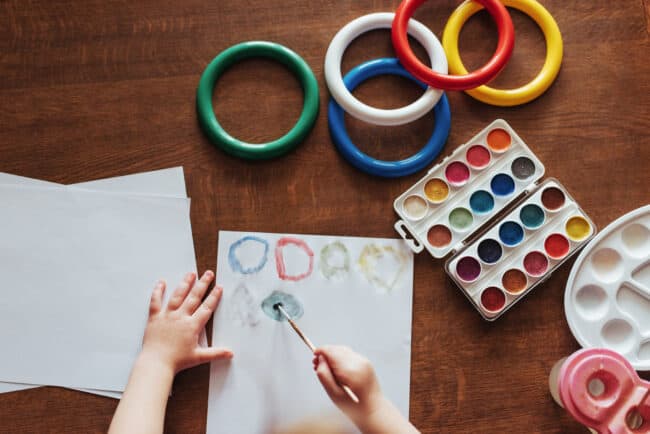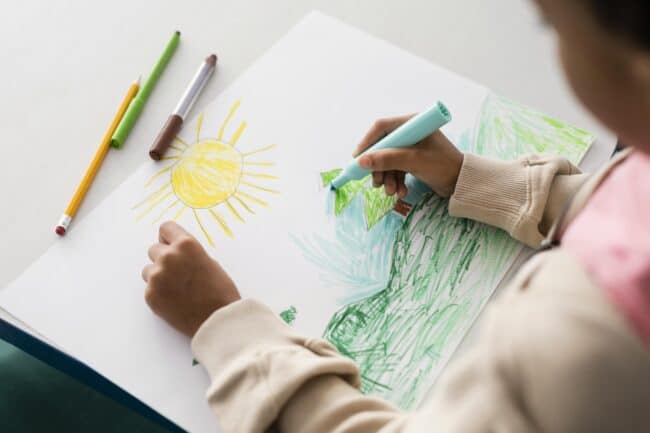Fun & Effective Ways to Teach your Kids to Draw
Every painting, sketch, or sculpture began with a scribble on paper. Here are ten fun ways you can effectively teach your kids to create a masterpiece.
Children are natural born artists. Just give them the right tools to scribble their ideas on paper and see them work their magic.
Teaching a child how to draw is mostly a question of observation and allowing the child space to explore new methods.
Yes, it can get messy sometimes, but in the long run, it improves their brain development and increases creativity skills.
I can’t Draw!
How many times have you heard this line: “I can’t draw!” or “I’m not good at art”?
Children feel this way when they don’t get the space, the right tools, or positive encouragement to draw.
Another possible reason is when you start your child off with a complicated drawing, which she is unable to grasp how to do.
This disappoints them as they realize that they’re unable to achieve the same results and pushes them away from anything to do with art.
The Benefits of Drawing
Learning how to draw helps kids improve their focus and concentration especially when it comes to academic subjects.
Drawing and artwork develops the ability to think critically about visual images, which helps in subjects such as math and also drawing from imagination which helps in biology.
As well as becoming good at academics, holding a pencil improves fine motor and coordination skills.
It also helps your children to process their emotions through drawing, and that can mean fewer meltdowns.
It has been proven that sketching and drawing help children with autism and dyslexia communicate their wants and needs to their parents.
Moreover, drawing helps in alleviating depression and anxiety so even the grownups can join in the fun.
Just like anything else, drawing takes practice. It is a skill that encompasses many different ideas which cannot be taught in a day.
Whether it is doodling, painting, sketching, or just plain drawing, here are ten fun, creative, and effective ways you can incorporate art into your little one’s life effortlessly.
1. Teach the Basics
If you hire an art tutor, you’ll see that they start off teaching basic shapes, sizes, and a variety of lines such as spirals, waves, and zigzags.
This basis helps in facilitating drawing ideas for beginners and using them to gravitate to make a basic house, tree, or a fish.
Helping them draw basic shapes aids in creating simple objects. Encourage them to use their imagination by turning a tree into a monster, for example.
If they get stuck, offer them ideas. Children are more motivated to draw if their loved ones join in with them. It makes it fun, inspiring, and educational.
2. Experiment with Different Mediums
Sometimes color pencils aren’t enough. Try out different media such as crayons, oil paints, watercolors, markers, chalk, and even different geometric tools like rulers.
A good rule of thumb is to start them with a pencil and a sketchbook before moving on to other media.
Let them explore and experiment with textures and colors. This allows them to be expressive and holds their interest in the field of art.
You can also use edible finger paints for younger children. Expect messiness, because no great things were created without a little mess.
In addition, make cleaning up fun too by using spray bottles to scrub off finger paints or allow them to use a water hose to clean the driveway drawn with chalk.
3. Try Various Types of Surfaces
As mentioned above, the driveway is just one of the surfaces that can be used to draw on with chalk.
You can also use markers to draw on plastic bags, or, in addition to traditional paper, you can give them cardboard, cardstock, construction papers, and even fabric to draw on.
In the case of fabrics, to make it more fun, you can embroider or needle punch their artwork onto the fabric they drew on.
This experimentation using various mediums on different kinds of materials holds their interest in art and also increases their creativity.
To make it more fun, there are scratch papers that allow you to use chopsticks or wooden kebab picks to draw anything of your choice. It is a great arts and crafts activity to do with your kids.
You can make it more fun by engaging them with questions like: “How can we turn this piece of paper into a masterpiece?”
You can also have a “drawing party” for them and their friends where they all get to try drawing on different surfaces using a variety of media.
They can also have art competitions with their siblings where the reward can be an extra bedtime story or something else enticing!

4. Encourage Them to Explore
Encourage your kids to explore and try new things. For instance, allow them to use both hands to draw.
Ask them to try drawing in a new perspective by lying on their stomachs or standing on their heads.
Encourage them to use a variety of colors in their drawing. Remember, when it comes to art, there’s no such thing as the wrong colors.
During the holiday season, they can draw on cards for their family members and friends. For instance, they can decorate and display Christmas holiday cards (with or without their pictures) on a big board or hang it around the house.
You can also encourage them to make greeting cards, get-well-soon cards, or birthday ones for their family or friends. This’ll inspire them to draw more creatively.
Related post: Avoid These Pottery Making Mistakes
5. Use Drawing Prompts
When out of ideas, use drawing prompts to get them started. Use prompts such as:
● Draw a family picture.
● Draw your favorite fruit.
● Draw your favorite superhero.
● Draw your favorite toy.
Using prompts like these helps children to use their imagination and also frees you to take care of chores. A win-win!
You can also provide visual aids of the above objects for them to draw. But if they like a challenge, drawing from imagination it is!
6. Use Gadgets
With current technology, these days you’ll find ipads and drawing and writing tablets for kids.
These tablets use special pens allowing you can change colors and erase mistakes with a touch of a button.
They come in unique designs and built-in memory systems where your kids’ drawings will be stored to review later.
7. Make Drawing a Part of Routine
As soon as they start holding a pencil, make drawing a part of their everyday routine. That way, they’ll develop an interest in art at a very young age.
As mentioned earlier, try giving them different items to use that is appropriate according to their age, so they don’t get bored easily.
8. Display Their Drawings and Artwork
Once your kids are done with their artwork, display it on the fridge or on a
board to let them know how precious their art is to you. It’ll give them a
sense of pride which will motivate them to draw more.
9. There is no Fixed Time for Drawing
If you’ve already fixed an allotted time for their drawing lessons, that’s absolutely fine! But if they’d like to keep drawing after the allotted time, let them. They’ll stop when they are ready.
Moreover, they may also ask if they can draw during odd times such as during bedtime. Let them! Drawing, painting, and coloring can help process emotions and maybe that’s just what they need.
10. It’s OK to Make Mistakes
As mentioned earlier, drawing, painting, and coloring can be messy. They may start coloring the walls, their clothes, or their hands and faces.
But what about the times when your child realizes she made a mistake? A straight line gone sideways or using the wrong color can upset anyone.
This is where they need to know that when it comes to drawing and creating art, mistakes will happen. And it’s absolutely okay! Encourage them to try again once their emotions are settled.
It is also important to note to not say the words: “You can’t draw” or “You didn’t draw it right.” Instead, you can observe their artwork and use dialogs such as:
● “Can you tell me about your drawing?”
● “That’s an interesting choice of colors.”
● “Wow, look at all the circles you made.”
Final Thoughts
Drawing is much like playing an instrument. The more you practice, the better you’ll get at creating art.
Most of the inspiration comes when children see their role models drawing and coloring.
When they begin, the remaining inspiration is covered when they start using different mediums like colored pencils, chalk, and crayons on a variety of surfaces such as cardboard, card stock, or a designed sketchbook.
Anticipate messiness and meltdowns which you can counter by remaining calm and making cleanup a fun experience. In no time, they’ll be able to create an unbelievable masterpiece.
Every painting, sketch, or sculpture began with a scribble on paper. Here are ten fun ways you can effectively teach your kids to create a masterpiece.

